Intel Unveils 10th Gen Core Ice Lake-U & Ice Lake-Y Mobile CPUs: 10nm Sunny Cove Later This Year
by Ian Cutress on May 29, 2019 8:00 AM EST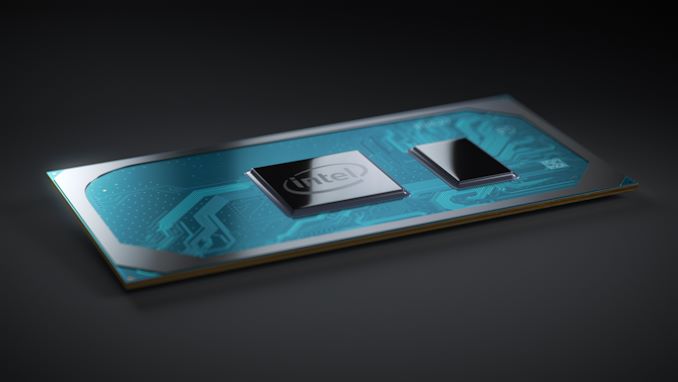
At Intel’s Keynote presentation here at Computex, the company finally lifted the lid on its first widely available new CPU design on its 10nm process, called Ice Lake. The official marketing name for these processors will be ‘Intel 10th Generation Core’, and will feature up to four CPU cores with Intel's new Sunny Cove architecture, new Gen11 graphics supplying up to 1TF of graphics/compute performance, and built in support for Wi-Fi 6 and Thunderbolt 3.
The story of Intel’s 10nm is a long and drawn out one, which we covered when we reviewed the first 10nm CPU, Cannon Lake, which only ended up in some limited Chinese system launch. Fast forward almost 2.5 years from when Intel officially announced it was shipping those 10nm CPUs and we have a full launch of Ice Lake, built on the company's greatly refined second-generation 10+ process. Intel spent a lot of its keynote presentation going through how it has driven the ecosystem and its ecosystem partners around developing systems with the new CPU in mind.
Intel is officially launching 11 different CPUs in the 10th Gen Core lineup, ranging from Core i3 to Core i7. Details on the specifications of those CPUs has not actually been released, which raises a number of questions of how much of a launch this actually is, however we do know that the best CPUs will have a turbo frequency up to 4.1 GHz and a top GPU frequency of 1.1 GHz. Users might consider this lower than 9th Gen mobile parts, which again raises questions. CPUs will be coming to market with 9W, 15W, and 28W variants.
Intel’s partners however have given us some specifications, and it shows in interesting adjustment in the naming scheme.
| OEM-Listed Intel Ice Lake 10nm CPUs | ||||||
| AnandTech | Core Threads |
Base Freq |
Turbo Freq |
IGP | TDP | Price (1ku) |
| i7-1065 G7 | 4C/8T | 1.3 GHz | 3.9 GHz | Yes | ? | ? |
| i5-1035 G1 | 4C/8T | ? | 3.7 GHz | Yes | ? | ? |
| i3-1005 G1 | 2C/4T | ? | 3.4 GHz | Yes | ? | ? |
At this point in time we’re not sure exactly what the ‘G7’ or ‘G1’ means in the name. It could be related to graphics, given that Intel will launch CPUs with 32 EUs, 48 EUs, or 64 EUs.
In accordance with their trio of TDPs, Intel has confirmed that there will be both Y-series and U-series Ice Lake parts. As a refresher, Intel's Y-series parts are their most compact, lowest-power chips, designed for passively cooled devices and other devices with limited cooling options, like 2-in-1s. Y-series chips have a nominal TDP of 9W – notably higher than the 5W TDPs for the current-generation Amber Lake-Y parts – and will be able to cTDP Up to 12W. Meanwhile Intel's U-series will, it appears, be the flag bearer for Ice Lake. These parts will have a nominal TDP of 15W, and can cTDP Up to 25W.
According to Intel's official product brief, both the U-series and Y-series parts will come with integrated GPUs with up to 64 EUs – this being particularly notable since the Y-series parts are going to be so low power. However it looks like Intel is going to split up the U-series a bit; 32 EU parts are listed as "Ice Lake U UHD", while 48 and 64 EU parts are "Ice Lake U Iris Plus". So Intel's Iris Plus branding will remain; and hopefully Iris Plus Ice Lake SKUs will be more common than today's Iris Plus parts.
Intel has discussed Ice Lake to a certain degree back in December and more recently at a private event, which we will be publishing after Computex to give it the attention it deserves. But the new core is designed to have more execution units, wider out-of-order windows, better load/store functionality, a bigger cache arrangement, and Intel states that this is good for an average 18% raw clock-for-clock performance uplift compared to the original Skylake core released in 2016.
Users might be surprised about this 18% number, given that Intel has historically only provided low single digit boosts in recent generations. The reason for those single digit boosts comes down mainly to small parts of the core microarchitecture being widened. For Ice Lake, the doubling of the L2 cache, the increase in execution ports, and the dispatch capabilities of the front end of the core all provide big improvements. Intel also states that the pre-fetchers are improved, which also helps with that 18% IPC increase. It will be interesting to get hold of a system and to actually test/compare with Skylake, especially with all the security patches applied.
For graphics, Intel is stating that the best 10th Gen Core designs will be able to compete with what AMD has to offer with its mobile APU platforms. By increasing the number of execution units from 24 EUs to 64 EUs, Intel is promising over a 2x boost in graphics performance, which is facilitated by the better cache design on the CPU. The new graphics architecture, along with aggressive driver updates, should provide Intel better positioning in the thin-and-light gaming market. Benchmarks shown by Intel include many of the popular titles running today at 1920x1080 at either low or medium settings.
Core functionality aside, the new chips are also incorporating some of the latest I/O features. The biggest news here, of course, is integrated Thunderbolt 3 support for the on-chip 300 series mobile chip, finally doing away with the need for a separate PCIe-to-Thunderbolt controller. Not only will this save laptop OEMs space in their design, but as it's now a baseline feature of Intel's mobile chips, Thunderbolt 3 should become nearly ubiquitous across low-power laptops. Which considering that Thunderbolt 3 has been released to the world at large to be used as the basis for USB4, it's clear that Thunderbolt technology is quickly going to become a necessary feature for future laptops.
The other notable change here is support for Wi-Fi 6 (802.11ax), via Intel's increasingly well-established CNVi program. As with Intel's first-generation integrated Wi-Fi 5 functionality, Wi-Fi 6 is integrated in two parts. The Wi-Fi 6 Media Access Controller (MAC) is on Intel's chipset, meanwhile the RF hardware is on a separate companion module. Going this route is optimal for OEMs for regulatory reasons – the RF module can be certified separately – though it does mean they'll need to buy the RF module to make use of the processor's on-chip Wi-Fi capabilities. Interestingly, neither Intel nor the rest of the industry is wasting any time here; even though the Wi-Fi 6 standard hasn't been fully approved yet – it's still draft – it's already being integrated into hardware wide and far, including now mobile PC processors.
Overall, a number of ecosystem partners are at the Computex show with 10th Gen Core designs, including Dell, HP, Lenovo and others. For this new generation, Intel is also pushing its new Athena project, which we're covering in a separate article.
AnandTech's deep dive coverage of Intel 10th Gen Core will continue after Computex, with more details an analysis of the core microarchitecture. We're also working with Intel to get more access to Ice Lake platforms so we can provide a full testing profile of the new CPU family.
| Want to keep up to date with all of our Computex 2019 Coverage? | ||||||
 Laptops |
 Hardware |
 Chips |
||||
| Follow AnandTech's breaking news here! | ||||||


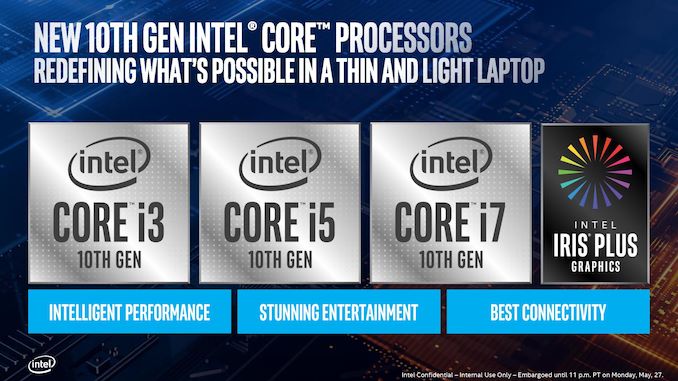
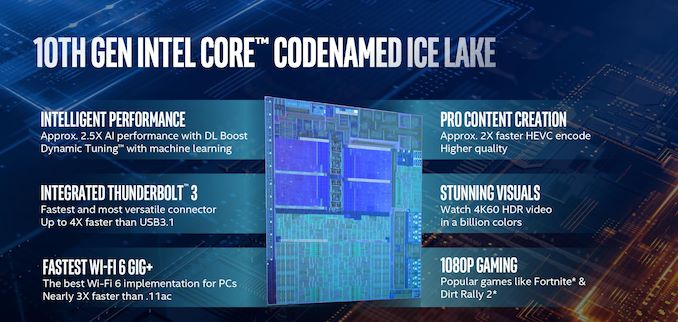
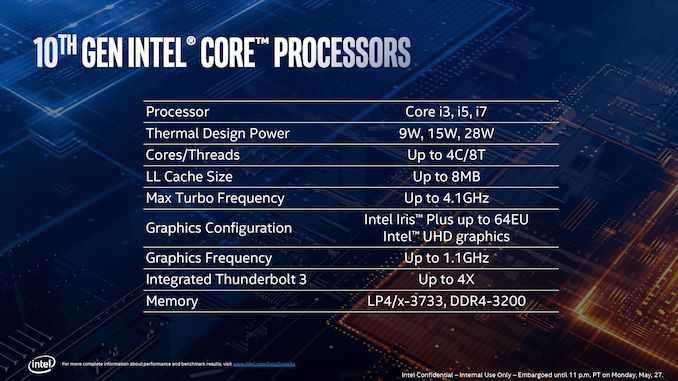
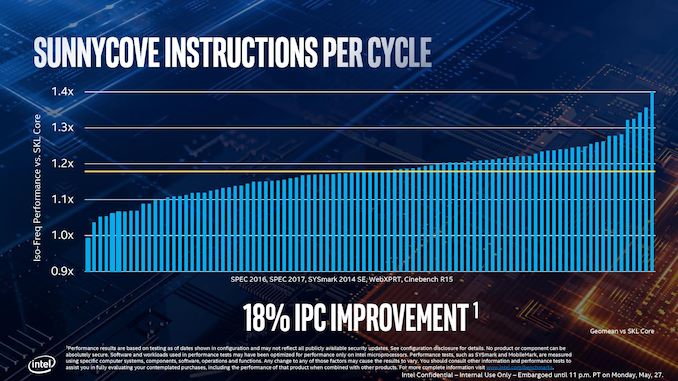
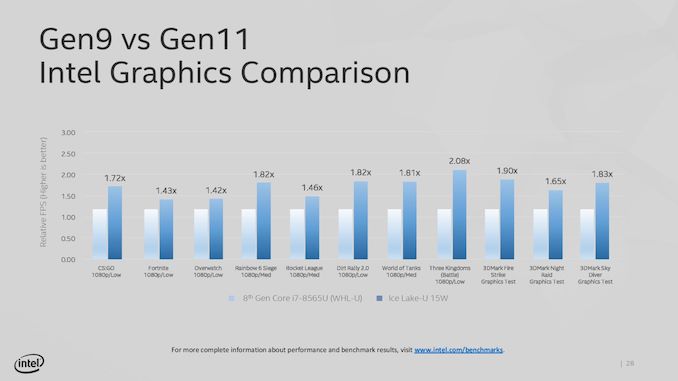
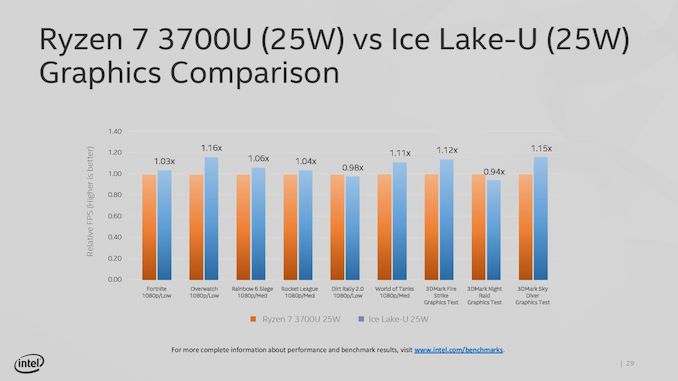
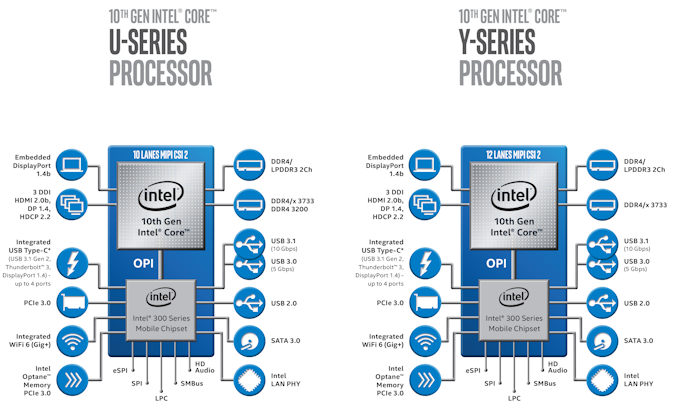








190 Comments
View All Comments
lightningz71 - Wednesday, May 29, 2019 - link
I wouldn't say that AMD will easily surpass this. The jump to 7nm for AMD's APUs will be an interesting one. It appears that AMD is currently content to have their mobile chips be based on mature nodes and aimed at a value position in the market. With that in mind, I suspect that Renoir, which is the code name for the next gen APU from AMD, will be based on the current 7nm process, will likely continue to be a monolithic die, will likely retain the 4 core, single CCX arrangement that they currently use, will likely have 1/2 the L3 of their existing 7nm CCX design (so, 8MB), and will likely have a NAVI based iGPU section, probably with 20 CUs (more CUs running at lower speeds can be more power efficient). The big gain for AMD will be that NAVI is expected to be more efficient with memory bandwidth (new caching structure, supports advanced features that save on bandwidth usage) and have support for faster DDR4 (though, I don't imagine that we'll be seeing anything much faster than DDR4-3200 in an SO-DIMM in wide usage by next year). I don't expect that AMD will have a memory controller that can support 4 X 32 bit LPDDR4X-3733, so will be at a bandwidth disadvantage.The one possibility that AMD has to surpass Intel here would be for them to leverage their experience with HBM and have Renoir be a design that is capable of being either independently packaged for lower cost applications, or being mounted on an Emib/MCM package and support a "back channel" connection to a 4GB HBM stack. A 20CU Navi with 4GB of dedicated HBM with appropriate clocks would likely be firmly in GT 1650/1660 territory, which would be just fine for 1080p gaming. That seems like a reasonable sweet spot for mobile devices and something that could also see reuse as a desktop APU for Home Theater machines that live in mini-ITX cases.
Zizy - Wednesday, May 29, 2019 - link
As Intel's upcoming solution is barely beating existing 3700U devices (in Intel tests), AMD will surely regain lead with 4700U even if it remains on the 12nm process. If it doesn't actually lead already in independent tests.Switching to 7nm is fairly likely next year (keeping just 2C/3CU cheap parts on 12nm) and will greatly surpass IceLake. But by then Intel will finally manage their dGPU. I wonder how this one ends up.
So far, GPU engineering hasn't shown anything wow, but with their new push in marketing they might launch something interesting. Or at least their PowerPoint will say so.
Hifihedgehog - Wednesday, May 29, 2019 - link
Navi + 7nm will likely smoke these Ice Lake parts. Someone has done some calculations comparing Ice Lake to Zen 2 in Geekbench and the IPC advantage is more like 6%, not the 18% that Intel was touting. They must have included AVX-512 (not just integer like AMD did) in the mix to give the appearance of extremely good IPC.Hifihedgehog - Wednesday, May 29, 2019 - link
EDIT: One of the Spec tests that Intel ran uses AVX-512. Not much out there utilizes it so that is very misleading on their part.Santoval - Wednesday, May 29, 2019 - link
Intel reported in a graph that Ice Lake-U has a 4% higher single thread performance than Whiskey Lake-U, with both at 15W. They did not compare them directly, because apparently it wouldn't look good. They set Broadwell at 1.00 performance, reporting ~1.43 for Whiskey Lake-U and ~1.47 for Ice Lake-U.What do you think the real number is? I was thinking ~2%, but if they employed AVX-512 to skew the score the actual gains might be in the 0% to 1% range. Basically the question is if their 10nm+ node's very low clocks ate *all* their IPC gains or if it left a few scraps of it. Which is why their main presentation had big graphs shouting about x2 iGPU performance(!), x2.5 AI performance(!) and ... 3 times higher wi-fi "performance"(!), with no word about CPU performance.
I smell a fiasco slowly brewing...
Santoval - Wednesday, May 29, 2019 - link
That +18% IPC was over the (original) Skylake that was released way back in 2015, not over Intel's current CPUs (i.e. since we talking about a TDP of 15W over Whiskey Lake-U). These are technically still based on the Skylake arch but have been optimized and refined multiple times, are fabbed on newer variants of 14nm etc etc Intel did not report the IPC gain over Whiskey Lake because it is obviously very low, and surely single digit. It is difficult to asses it because Intel did not disclose base clocks, but it should be in the 6 to 8% range.ajp_anton - Wednesday, May 29, 2019 - link
Whiskey Lake has identical IPC to Skylake because it *is* Skylake. It has some security fixes, but other than that, they are the same. Faster RAM might give the illusion of slightly higher "IPC", but the only real improvement is the improved manufacturing leading to higher clocks. Actually the clocks have been improved so much that since Skylake we have pretty much had the biggest generation-over-generation performance improvements since Sandy. At least running stock clocks.Korguz - Wednesday, May 29, 2019 - link
ajp_anton.. tell that to HStewart.. he has been saying for a while now that what intel is realeasing now.. is a new architeCture.. when all it is.. is yet another update/refresh...HStewart - Wednesday, May 29, 2019 - link
Look at architexture on chip Korguz, and tell me that it not different than Skylake, it has more ALUs and other logic, larger cache and besides that also AVX-512 and other enhancements. It would be pure stupidly to say it is update/refresh on skylake. Of course you maybe talking about WhiskeyLake and not Ice Lake which I referring to.One difference that I just realize was started on my Dell XPS 15 2in1 Kaby Lake G and available in these new processors in Dynamic Tuning, plus there are other aspects but core IPC performance of Skylake series is same - but they adjusted parts of it.
But I think you were confused between IceLake and other processors - yes we all don't live in desktop line and who knows why Intel calls new desktops 10 series on 14nm.
Korguz - Wednesday, May 29, 2019 - link
HStewart.. 1st.. do you NOT know how to spell ??? its architeCture... NOT architexture.. for some one who says he has been using computers for as long as you " say " you have.. you would think you would know how to spell it CORRECTLY.2nd.. it ISNT'T different then skylake.. its just a refresh/update to an EXISTING architeCture that intel has been feeding us for 6 or 7 YEARS now
" it has more ALUs and other logic, larger cache and besides that also AVX-512 and other enhancements. " what do you think and update/refresh is??? Amd going from bulldozer to zen
THAT is a new architeCture... what intel is doing is NOT but you are too much of an intel fanboy to realize this. you keep believing intels bs and lies.. wake up HStewart.. stop being the fanboy you are.. and open your eyes